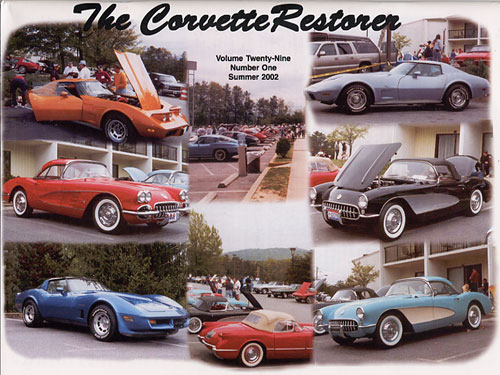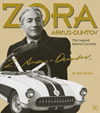|
Zora Arkus-Duntov: The Legend Behind Corvette
by Jerry Burton
Price: $49.95
|

The Corvette Restorer - Summer 2002
Think how you feel when a person you"re sure you know like the back of your hand reveals a side you"ve never seen before: Part shock, right? Part disbelief? Part guilt for being so inattentive? Genuine Vetteophiles - which is to say the entire NCCC membership -- will get that feeling as they read a pair of splendid new Corvette books -- Jerry Burton"s Zora, a biography of Zora Arkus-Duntov, and Dave McLellan"s Corvette from the Inside. A lot of us knew Zora pretty well. Dave, too. But hardly any of us knew the burdens they carried as they fought the good fight inside General Motors on behalf of the Corvette. Now, at last, we do. Duntov had long since retired as Corvette"s chief engineer when I turned up in 1979 as a wet-behind-the-ears recruit to the Chevrolet public relations staff. He was the white-haired old man with the piercing blue eyes and heavy accent who rushed past me once in a while to visit my boss, Chevy"s then PR director Jim Williams. Zora always rushed. Meanwhile, McLellan, who succeeded Zora January 1, 1975, was a precocious young engineer for whom the word "erudite" must have been invented. The kid and his predecessor seemed as un-alike as the rebellious "70s were the "50s. Except the rebel was not the fashionably bell-bottomed McLellan. It was Duntov, bowed but not broken, ever the renegade, an old soldier who was not about to fade away. Duntov fought the system. McLellan worked it. That, I knew in "79. I came to know more over the years. I watched Zora become a god to Corvette aficianodos. I like to think I helped Dave make his mark on the Corvettes of the "80s and "90s and on the Corvette scene. And now I"m embarrassed to say I"m finally getting to know them.
A Review of Zora Zora is Jerry Burton"s first book. It is also Elfi"s. Jerry is editorial director for several Campbell-Ewald publications, including Corvette Quarterly. Fifteen years ago, he was a C-E copywriter. His job was to shrink the great thoughts of Chevy marketers into tiny strings of words so sticky that car buyers couldn"t get them out of their minds. He was very good. "Chevy Thunder" was a catch-phrase we were then using to glorify the small-block V8 engine. To which Jerry added the three words that gave it immortality: "Heartbeat of America." It became an unforgettable Chevy mantra. He hasn"t lost his touch.
Elfi, of course, is the leading lady in Zora"s life. They met in the mid-"30s in Berlin. He was handsome, 25 and broke. She was 15, beautiful and rich. It was love at first sight. And what a love it was. They"d been married almost 60 years when Zora died in 1996.
Elfi still lives in their house on Lochmoor not far from Lake St. Clair. This is as much her book as his. When they make it a movie (and oh, my goodness they must) I"d cast Brittney Spears to play Elfi, the younger, and maybe Ingrid Bergman for her later years. I know, I know. But only Ingrid could do justice to Elfi.
Soon after Zora died, Elfi persuaded Jerry to write the book. Then, she told him the love story. Or,more correctly, the stories. They emerged from hundreds of hours Jerry spent with Elfi pouring over old memos and ancient memories.
You want proof that truth really is stranger than fiction? Read Zora.
The stories range from adolescent high-jinks to danger-filled escapades in war-torn Europe to the high life of London, New York, and, yes, Detroit, to infidelities and separations - both forced and voluntary -- to spats and tantrums and exquisite reconciliations.
They"re in the book. In many ways they are the book. The passion with which Zora and Elfi loved each other, fought with and for each other, protected each other is the passion that Zora seems to have brought to everything he did. Lucky for us, he did Corvettes.
Jerry details how Zora - boy genius turned refugee, turned soldier, turned racer, turned businessman --saw the Motorama show car at New York"s Waldorf-Astoria hotel in January, 1953. He found its mechanicals awful, but fixable. And he fell head-over-heels in love with its looks.
(When the millionth Vette was built in 1992, we invited Zora and a couple hundred other heroes of Corvette wars to lunch at the St. Regis Hotel in Detroit. Everybody got a special limited edition Franklin Mint model of a "53 under a banner that I think still best defines the car: "Greatness Endures." Zora took his and held it up. "Hmmmmm," he said in his inimitable accent. "Eeeez very good." He opened the tiny hood and pointed to the engine. "Eeeez very bad." )
No question that first "53 show car sighting greatly affected Zora. Having made and lost big money in various ventures after the war, he was looking for steady work. He"d written Chevy chief engineer Ed Cole about hiring him in Detroit. Or maybe oversees? Anywhere? He heard nothing. He wrote again, then again. Finally, he landed an interview. On May 1, 1953, he went to work at Chevy as a $14,000-a-year assistant staff engineer. Unbeknownst to everybody, that was the day he adopted the Corvette. Until the day he died, he would not, could not, give it up.
From the get-go, Zora rocked the Chevy boat. Within days of signing on, he wanted time off to drive in the "53 Le Mans 24-hour. "No," he was told. "I go," he insisted. He did. Rebuffed by GM internals, he found audience for his views on the virtues of automotive high performance at SAE meetings, where his convoluted English got him dubbed the Victor Borge of engineering.
He crafted elegant memos to GM execs he wasn"t supposed to talk to. He raced Porsches. He rode SAC aircraft with Gen. Curtis LeMay. He helped the best of the best among America"s growing cadre of road racers -- people like John Fitch, Dick Thompson, Walt Hansgten, Dick Guldstrand, Bob Bondaurant, Dan Gurney, Dave MacDonald, Jim Jeffords -- put production Corvettes in winner circles wherever racers raced.
And when thwarted by the competition or corporate edict, he went underground. He ran a skunkworks within Chevy engineering that produced record-setting Pikes Peak hill climbers, the 150-mph Daytona cars, the star-crossed 1957 Corvette SS, The Le Mans Vettes of 1960, the Grand Sports, CERV I and II, the XP-882 (aka Aerovette.) XP-882, by the way, was Zora"s ultimate dream Corvette. Low-slung, mid-engine, it was the essence of world leadership in design and engineering. Zora thought it was moving toward mid-"70s production. Then it was killed along with Ed Cole"s ill-fated Wankel rotary engine program.
His legendary battles with GM styling boss Bill Mitchell got him banned more than once from design staff studios where future Corvettes were taking shape. His disregard for things like speed limits kept him in the crosshairs of police departments throughout metro Detroit and got him occasionally banned from GM test tracks. His creativeness in circumventing the cursed AMA racing ban imposed in 1957and still in effect when he retired earned him scoldings and more than a few trips to GM"s corporate woodshed.
Chagrined once at what he consider a paltry (and punitive) annual bonus, he turned it down. Cole, by now GM president, called him in and angrily told him to resign. Zora refused.
Jerry says Zora"s retirement party in December, "74, was bittersweet. Hundreds showed up. Cole spoke long. "Zora managed to bootleg more things through Chevrolet than any other engineer that I"ve ever known." he said. "You could never turn him off. That was damned good for Chevy, even if it caused chaos in the accounting department?
"I just want to say that I am very happy and was very privileged to have a chance to work with this most incredible man. He knew how to get the job done?"
Which is a pretty good summation for Jerry Burton"s 125,000-word, 24-chapter must-read opus (minus epilogue, notes and credits.)
Zora Arkus-Duntov: There was nothing about the word "no" that he understood.



![[B] Bentley Publishers](http://assets1.bentleypublishers.com/images/bentley-logos/bp-banner-234x60-bookblue.jpg)
